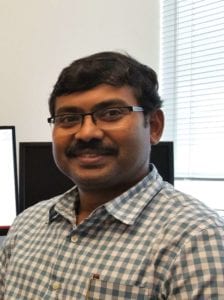
“Learn from yesterday, work for today, plan for tomorrow, dream for the day after tomorrow…and most of your dreams will come true.”
Supriyo De, MD/PhD, is a Staff Scientist at the National Institute on Aging (NIA), part of the National Institutes of Health (NIH). He is a leading bioinformatics expert focusing on the integration of high-throughput data to investigate age-related diseases.
Burcu Darst, ASHG: Briefly describe your current position and academic interests.
Dr. De: I am a Staff Scientist in the Laboratory of Genetics and Genomics and the person in charge of genomic data analysis for the whole Intramural Research Program (IRP) of the NIA. I am also the coordinator of the Biomedical Data Science Initiative at NIA-IRP.
The goals of the Initiative are to integrate the efforts and individual expertise of about two dozen data analysts at our institute, and to train the fellows and interns in data analysis skills.
My research interest is in integrating the various types of high-throughput data such as genomics, transcriptomics, proteomics, metabolomics, etc. to address complex biological questions of human aging and age-related diseases. My mentoring interest is to train fellows and interns in data analysis.
ASHG: Which aspects of your training were crucial to get you where you are now?
Dr. De: By profession, I was a general surgeon, but I educated myself in computational biology. For the last 25 years, I have learned on my own Linux and a host of other programming languages. Also, I earned my PhD degree in molecular biology while working as a teaching assistant in biostatistics.
I believe that integrating medicine, molecular biology, computer science, and statistics has helped me a lot to get where I am now.
ASHG: What are the biggest challenges and rewards of your job?
Dr. De: Computationally, one of the biggest challenges that I am facing now is long-term data storage and data transfer over the internet.
In the short term, the biggest reward of data analysis is the ability to summarize huge datasets into intuitive figures that convey biological information. To me, this is like creating art with data and is essential for communicating biomedical discoveries. In the long term, it will be most rewarding for me if the computational analysis leads to advances in Alzheimer’s research.
ASHG: Are there aspects of your work that you did not expect to be doing?
Dr. De: I love to teach. When I joined NIH, I did not expect to have so many teaching opportunities. Since the launch of the Biomedical Data Science Initiative earlier in 2017, my teaching ambition is becoming realized.
ASHG: What advice would you give your former trainee-self?
Dr. De: Interdisciplinary research is among the hardest fields to master, but in today’s biomedical landscape, it is one of the best paths to establishing a rewarding career.
ASHG: What are the most important skills for a career in bioinformatics and genetics?
Dr. De: Knowing at least one programming or scripting method such as Python or R and getting accustomed to Linux are the most important skills in my view. Then it becomes so much easier to handle large volumes of data. Beyond that, learning to use cloud computing cost-effectively is also an important skill to master.
ASHG: Any final words of advice for those interested in these fields?
Dr. De: The best way to learn bioinformatics/computational biology is just by doing it. Classes only give you an outline to follow and Google helps you find a solution to the computational problem at hand. But doing the hands-on analysis is vitally important.
Also, for all trainees I would like to share my motto: learn from yesterday, work for today, plan for tomorrow, dream for the day after tomorrow…and most of your dreams will come true.
Want more interviews? Join the ASHG Trainee Forum to keep up with new ones!
